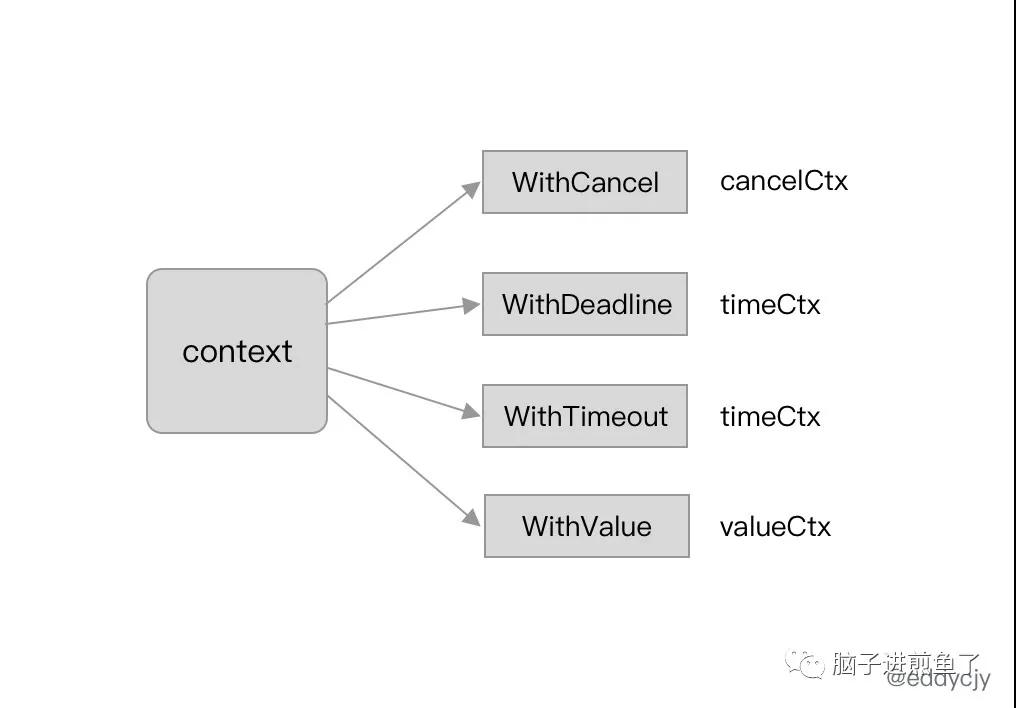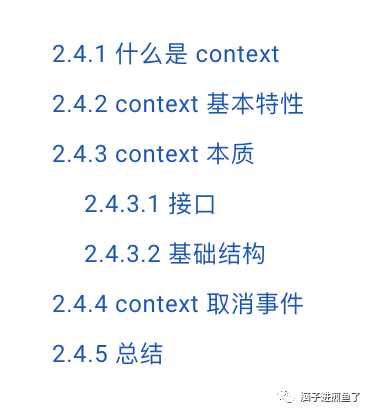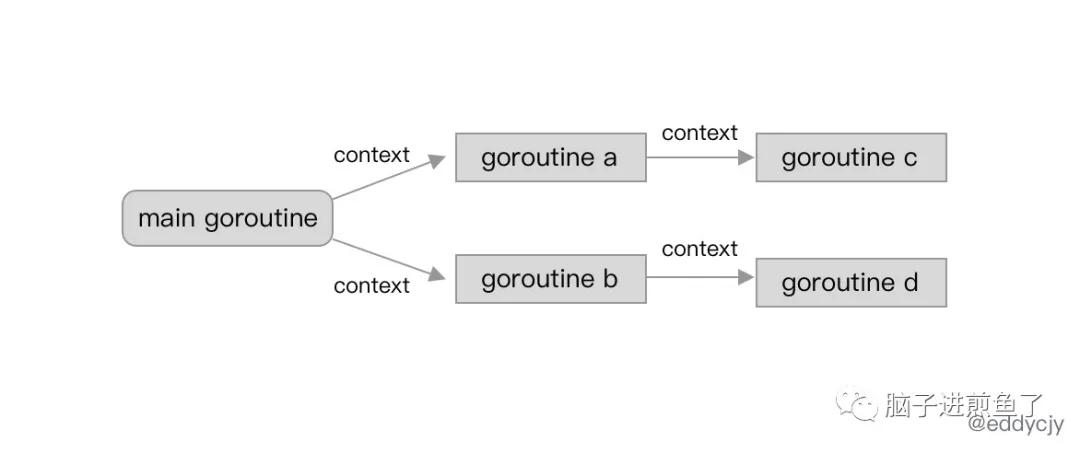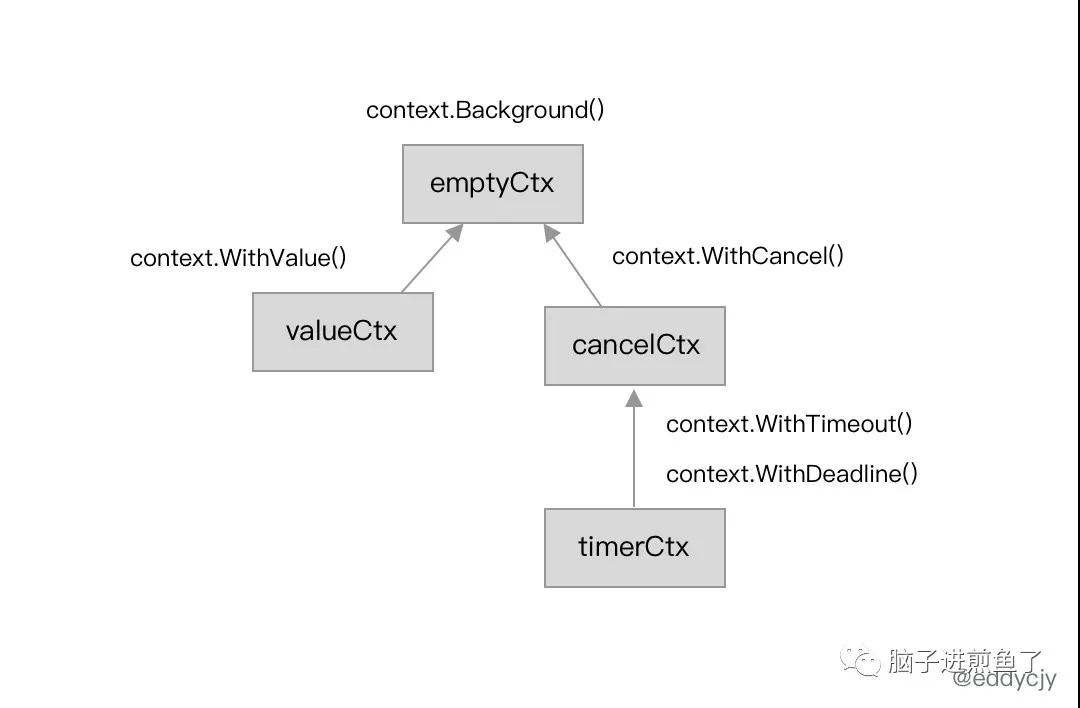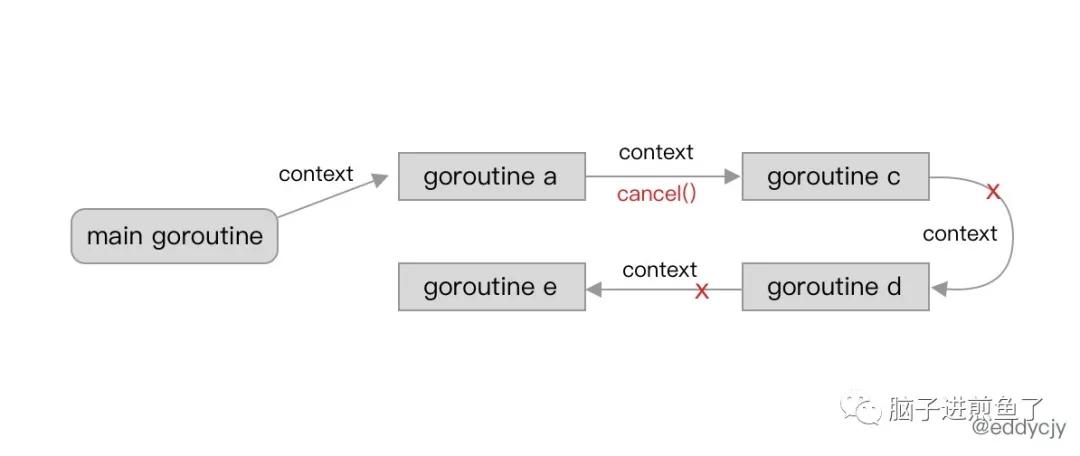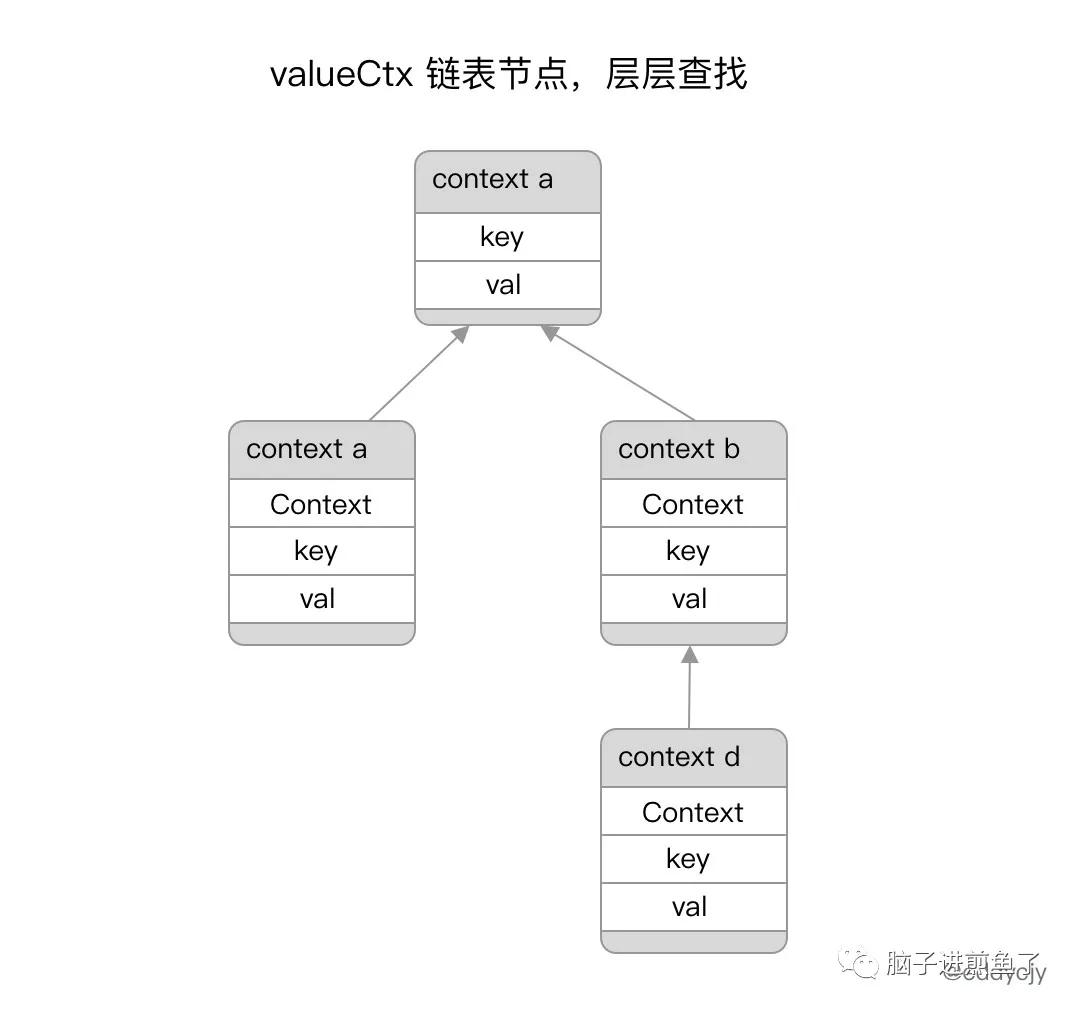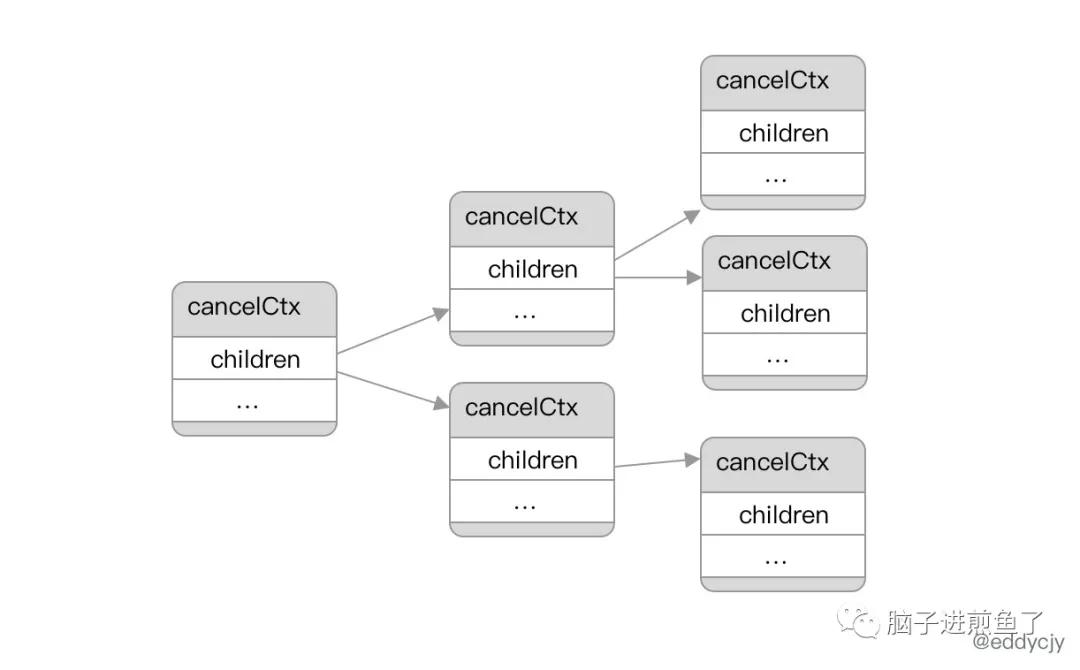一文吃透 Go 語言解密之上下文 Context
大家好,我是煎魚。
上下文(Context)是 Go 語言中非常有特色的一個特性, 在 Go 1.7 版本中正式引入新標準庫 context。
其主要的作用是在 goroutine 中進行上下文的傳遞,而在傳遞信息中又包含了 goroutine 的運行控制、上下文信息傳遞等功能。
為加強大家對 Go 語言的 context 的設計,本文將對標準庫 context 進行深入剖析,看看他里面到底暗含了何物,又為何能夠做那么多事。
整體的描述結構是:“了解 context 特性,熟悉 context 流程,剖析 context 原理” 三個板塊進行。目錄如下:
什么是 context
Go 語言的獨有的功能之一 Context,最常聽說開發者說的一句話就是 “函數的第一個形參真的要傳 ctx 嗎?”,第二句話可能是 “有沒有什么辦法不傳,就能達到傳入的效果?”,聽起來非常魔幻。
在 Go 語言中 context 作為一個 “一等公民” 的標準庫,許多的開源庫都一定會對他進行支持,因為標準庫 context 的定位是上下文控制。會在跨 goroutine 中進行傳播:
本質上 Go 語言是基于 context 來實現和搭建了各類 goroutine 控制的,并且與 select-case聯合,就可以實現進行上下文的截止時間、信號控制、信息傳遞等跨 goroutine 的操作,是 Go 語言協程的重中之重。
context 基本特性
演示代碼:
- func main() {
- parentCtx := context.Background()
- ctx, cancel := context.WithTimeout(parentCtx, 1*time.Millisecond)
- defer cancel()
- select {
- case <-time.After(1 * time.Second):
- fmt.Println("overslept")
- case <-ctx.Done():
- fmt.Println(ctx.Err())
- }
- }
輸出結果:
- context deadline exceeded
我們通過調用標準庫 context.WithTimeout 方法針對 parentCtx 變量設置了超時時間,并在隨后調用 select-case 進行 context.Done 方法的監聽,最后由于達到截止時間。因此邏輯上 select 走到了 context.Err 的 case 分支,最終輸出 context deadline exceeded。
除了上述所描述的方法外,標準庫 context 還支持下述方法:
- func WithCancel(parent Context) (ctx Context, cancel CancelFunc)
- func WithDeadline(parent Context, d time.Time) (Context, CancelFunc)
- func WithTimeout(parent Context, timeout time.Duration) (Context, CancelFunc)
- type Context
- func Background() Context
- func TODO() Context
- func WithValue(parent Context, key, val interface{}) Context
- WithCancel:基于父級 context,創建一個可以取消的新 context。
- WithDeadline:基于父級 context,創建一個具有截止時間(Deadline)的新 context。
- WithTimeout:基于父級 context,創建一個具有超時時間(Timeout)的新 context。
- Background:創建一個空的 context,一般常用于作為根的父級 context。
- TODO:創建一個空的 context,一般用于未確定時的聲明使用。
- WithValue:基于某個 context 創建并存儲對應的上下文信息。
context 本質
我們在基本特性中介紹了不少 context 的方法,其基本大同小異。看上去似乎不難,接下來我們看看其底層的基本原理和設計。
context 相關函數的標準返回如下:
- func WithXXXX(parent Context, xxx xxx) (Context, CancelFunc)
其返回值分別是 Context 和 CancelFunc,接下來我們將進行分析這兩者的作用。
接口
1. Context 接口:
- type Context interface {
- Deadline() (deadline time.Time, ok bool)
- Done() <-chan struct{}
- Err() error
- Value(key interface{}) interface{}
- }
- Deadline:獲取當前 context 的截止時間。
- Done:獲取一個只讀的 channel,類型為結構體。可用于識別當前 channel 是否已經被關閉,其原因可能是到期,也可能是被取消了。
- Err:獲取當前 context 被關閉的原因。
- Value:獲取當前 context 對應所存儲的上下文信息。
2. Canceler 接口:
- type canceler interface {
- cancel(removeFromParent bool, err error)
- Done() <-chan struct{}
- }
- cancel:調用當前 context 的取消方法。
- Done:與前面一致,可用于識別當前 channel 是否已經被關閉。
基礎結構
在標準庫 context 的設計上,一共提供了四類 context 類型來實現上述接口。分別是 emptyCtx、cancelCtx、timerCtx 以及 valueCtx。
emptyCtx
在日常使用中,常常使用到的 context.Background 方法,又或是 context.TODO 方法。
源碼如下:
- var (
- background = new(emptyCtx)
- todo = new(emptyCtx)
- )
- func Background() Context {
- return background
- }
- func TODO() Context {
- return todo
- }
其本質上都是基于 emptyCtx 類型的基本封裝。而 emptyCtx 類型本質上是實現了 Context 接口:
- type emptyCtx int
- func (*emptyCtx) Deadline() (deadline time.Time, ok bool) {
- return
- }
- func (*emptyCtx) Done() <-chan struct{} {
- return nil
- }
- func (*emptyCtx) Err() error {
- return nil
- }
- func (*emptyCtx) Value(key interface{}) interface{} {
- return nil
- }
實際上 emptyCtx 類型的 context 的實現非常簡單,因為他是空 context 的定義,因此沒有 deadline,更沒有 timeout,可以認為就是一個基礎空白 context 模板。
cancelCtx
在調用 context.WithCancel 方法時,我們會涉及到 cancelCtx 類型,其主要特性是取消事件。源碼如下:
- func WithCancel(parent Context) (ctx Context, cancel CancelFunc) {
- c := newCancelCtx(parent)
- propagateCancel(parent, &c)
- return &c, func() { c.cancel(true, Canceled) }
- }
- func newCancelCtx(parent Context) cancelCtx {
- return cancelCtx{Context: parent}
- }
其中的 newCancelCtx 方法將會生成出一個可以取消的新 context,如果該 context 執行取消,與其相關聯的子 context 以及對應的 goroutine 也會收到取消信息。
首先 main goroutine 創建并傳遞了一個新的 context 給 goroutine b,此時 goroutine b 的 context 是 main goroutine context 的子集:
傳遞過程中,goroutine b 再將其 context 一個個傳遞給了 goroutine c、d、e。最后在運行時 goroutine b 調用了 cancel 方法。使得該 context 以及其對應的子集均接受到取消信號,對應的 goroutine 也進行了響應。
接下來我們針對 cancelCtx 類型來進一步看看:
- type cancelCtx struct {
- Context
- mu sync.Mutex // protects following fields
- done chan struct{} // created lazily, closed by first cancel call
- children map[canceler]struct{} // set to nil by the first cancel call
- err error // set to non-nil by the first cancel call
- }
該結構體所包含的屬性也比較簡單,主要是 children 字段,其包含了該 context 對應的所有子集 context,便于在后續發生取消事件的時候進行逐一通知和關聯。
而其他的屬性主要用于并發控制(互斥鎖)、取消信息和錯誤的寫入:
- func (c *cancelCtx) Value(key interface{}) interface{} {
- if key == &cancelCtxKey {
- return c
- }
- return c.Context.Value(key)
- }
- func (c *cancelCtx) Done() <-chan struct{} {
- c.mu.Lock()
- if c.done == nil {
- c.done = make(chan struct{})
- }
- d := c.done
- c.mu.Unlock()
- return d
- }
- func (c *cancelCtx) Err() error {
- c.mu.Lock()
- err := c.err
- c.mu.Unlock()
- return err
- }
在上述代碼中可以留意到,done 屬性(只讀 channel)是在真正調用到 Done 方法時才會去創建。需要配合 select-case 來使用。
timerCtx
在調用 context.WithTimeout 方法時,我們會涉及到 timerCtx 類型,其主要特性是 Timeout 和 Deadline 事件,源碼如下:
- func WithTimeout(parent Context, timeout time.Duration) (Context, CancelFunc) {
- return WithDeadline(parent, time.Now().Add(timeout))
- }
- func WithDeadline(parent Context, d time.Time) (Context, CancelFunc) {
- ...
- c := &timerCtx{
- cancelCtx: newCancelCtx(parent),
- deadline: d,
- }
- }
你可以發現 timerCtx 類型是基于 cancelCtx 類型的。我們再進一步看看 timerCtx 結構體:
- type timerCtx struct {
- cancelCtx
- timer *time.Timer // Under cancelCtx.mu.
- deadline time.Time
- }
其實 timerCtx 類型也就是 cancelCtx 類型,加上 time.Timer 和對應的 Deadline,也就是包含了時間屬性的控制。
我們進一步看看其配套的 cancel 方法,思考一下其是如何進行取消動作的:
- func (c *timerCtx) Deadline() (deadline time.Time, ok bool) {
- return c.deadline, true
- }
- func (c *timerCtx) cancel(removeFromParent bool, err error) {
- c.cancelCtx.cancel(false, err)
- if removeFromParent {
- removeChild(c.cancelCtx.Context, c)
- }
- c.mu.Lock()
- if c.timer != nil {
- c.timer.Stop()
- c.timer = nil
- }
- c.mu.Unlock()
- }
先會調用 cancelCtx 類型的取消事件。若存在父級節點,則移除當前 context 子節點,最后停止定時器并進行定時器重置。而 Deadline 或 Timeout 的行為則由 timerCtx 的 WithDeadline 方法實現:
- func WithDeadline(parent Context, d time.Time) (Context, CancelFunc) {
- if cur, ok := parent.Deadline(); ok && cur.Before(d) {
- // The current deadline is already sooner than the new one.
- return WithCancel(parent)
- }
- ...
- }
該方法會先進行前置判斷,若父級節點的 Deadline 時間早于當前所指定的 Deadline 時間,將會直接生成一個 cancelCtx 的 context。
- func WithDeadline(parent Context, d time.Time) (Context, CancelFunc) {
- ...
- c := &timerCtx{
- cancelCtx: newCancelCtx(parent),
- deadline: d,
- }
- propagateCancel(parent, c)
- dur := time.Until(d)
- if dur <= 0 {
- c.cancel(true, DeadlineExceeded) // deadline has already passed
- return c, func() { c.cancel(false, Canceled) }
- }
- c.mu.Lock()
- defer c.mu.Unlock()
- if c.err == nil {
- c.timer = time.AfterFunc(dur, func() {
- c.cancel(true, DeadlineExceeded)
- })
- }
- return c, func() { c.cancel(true, Canceled) }
- }
接下來將會正式生成成為一個 timeCtx 類型,并將其加入到父級 context 是 children 屬性中。最后進行當前時間與 Deadline 時間的計算,并通過調用 time.AfterFunc 在到期后自動調用 cancel 方法發起取消事件,自然也就會觸發父子級的事件傳播。
valueCtx
在調用 context.WithValue 方法時,我們會涉及到 valueCtx 類型,其主要特性是涉及上下文信息傳遞,源碼如下:
- func WithValue(parent Context, key, val interface{}) Context {
- ...
- if !reflectlite.TypeOf(key).Comparable() {
- panic("key is not comparable")
- }
- return &valueCtx{parent, key, val}
- }
你會發現 valueCtx 結構體也非常的簡單,核心就是鍵值對:
- type valueCtx struct {
- Context
- key, val interface{}
- }
其在配套方法上也不會太復雜,基本就是要求可比較,接著就是存儲匹配:
- func (c *valueCtx) Value(key interface{}) interface{} {
- if c.key == key {
- return c.val
- }
- return c.Context.Value(key)
- }
這時候你可能又有疑問了,那多個父子級 context 是如何實現跨 context 的上下文信息獲取的?
這秘密其實在上面的 valueCtx 和 Value 方法中有所表現:
本質上 valueCtx 類型是一個單向鏈表,會在調用 Value 方法時先查詢自己的節點是否有該值。若無,則會通過自身存儲的上層父級節點的信息一層層向上尋找對應的值,直到找到為止。
而在實際的工程應用中,你會發現各大框架,例如:gin、grpc 等。他都是有自己再實現一套上下文信息的傳輸的二次封裝,本意也是為了更好的管理和觀察上下文信息。
context 取消事件
在我們針對 context 的各類延伸類型和源碼進行了分析后。我們進一步提出一個疑問點,context 是如何實現跨 goroutine 的取消事件并傳播開來的,是如何實現的?
這個問題的答案就在于 WithCancel 和 WithDeadline 都會涉及到 propagateCancel 方法,其作用是構建父子級的上下文的關聯關系,若出現取消事件時,就會進行處理:
- func propagateCancel(parent Context, child canceler) {
- done := parent.Done()
- if done == nil {
- return
- }
- select {
- case <-done:
- child.cancel(false, parent.Err())
- return
- default:
- }
- ...
- }
- 當父級上下文(parent)的 Done 結果為 nil 時,將會直接返回,因為其不會具備取消事件的基本條件,可能該 context 是 Background、TODO 等方法產生的空白 context。
- 當父級上下文(parent)的 Done 結果不為 nil 時,則發現父級上下文已經被取消,作為其子級,該 context 將會觸發取消事件并返回父級上下文的取消原因。
- func propagateCancel(parent Context, child canceler) {
- ...
- if p, ok := parentCancelCtx(parent); ok {
- p.mu.Lock()
- if p.err != nil {
- child.cancel(false, p.err)
- } else {
- if p.children == nil {
- p.children = make(map[canceler]struct{})
- }
- p.children[child] = struct{}{}
- }
- p.mu.Unlock()
- } else {
- atomic.AddInt32(&goroutines, +1)
- go func() {
- select {
- case <-parent.Done():
- child.cancel(false, parent.Err())
- case <-child.Done():
- }
- }()
- }
- }
經過前面一個代碼片段的判斷,已得知父級 context 未觸發取消事件,當前父級和子級 context 均正常(未取消)。
將會執行以下流程:
- 調用 parentCancelCtx 方法找到具備取消功能的父級 context。并將當前 context,也就是 child 加入到 父級 context 的 children 列表中,等待后續父級 context 的取消事件通知和響應。
- 調用 parentCancelCtx 方法沒有找到,將會啟動一個新的 goroutine 去監聽父子 context 的取消事件通知。
通過對 context 的取消事件和整體源碼分析,可得知 cancelCtx 類型的上下文包含了其下屬的所有子節點信息:
也就是其在 children 屬性的 map[canceler]struct{} 存儲結構上就已經支持了子級關系的查找,也就自然可以進行取消事件傳播了。
而具體的取消事件的實際行為,則是在前面提到的 propagateCancel 方法中,會在執行例如cacenl 方法時,會對父子級上下文分別進行狀態判斷,若滿足則進行取消事件,并傳播給子級同步取消。
總結
作為 Go 語言的核心功能之一,其實標準庫 context 非常的短小精悍,使用的都是基本的數據結構和理念。既滿足了跨 goroutine 的調控控制,像是并發、超時控制等。
同時也滿足了上下文的信息傳遞。在工程應用中,例如像是鏈路ID、公共參數、鑒權校驗等,都會使用到 context 作為媒介。
目前官方對于 context 的建議是作為方法的首參數傳入,雖有些麻煩,但也有人選擇將其作為結構體中的一個屬性傳入。但這也會帶來一些心智負擔,需要識別是否重新 new 一個。
也有人提出希望 Go2 取消掉 context,換成另外一種方法,但總體而言目前未見到正式的提案,這是我們都需要再思考的。














